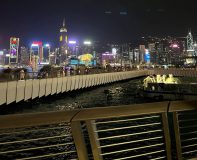Pacific Rim, Guillermo del Toro, 2013
Pacific Rim was released by Warner Bros in 2013.Hong Kong is set as a background for the final combat scene between the protagonist, Warriors and antagonist, Kaiju which appears in the later stage of the film. The scene transitions to the cityscape of Hong Kong showing the transporting of Warriors into the lake of Kowloon Bay. The iconic night cityscape of Hong Kong can be seen in the background such as the tower for Bank Of China, the ICC tower and IFC, capturing the notable and iconic nightscape of Hong Kong. The sense of modern and glamorous look of Hong Kong is emphasized as the lighting and vibrancy of Hong Kong cityscape is increased, capturing the busy and loud Hong Kong.
Eureka (One of Warrios) Landing onto Kowloon Bay¹

How Kowloon Bay is perceived from normal human’s perspective
The Kowloon Bay of Hong Kong seen in film compared to real life contrasts dramatically in various ways. In reality, for individuals to see the whole iconic night cityscape of Hong Kong, individuals would have to travel to the opposite side inorder to capture the view at once. However, in the film, Kowloon Bay is viewed from a downward angle from the sky which makes it seem as if the Kowloon Bay is smaller than in reality. Additionally ginormous entities (Kaiju and Warriors) are placed next to it which furthers the sense of Hong Kong cityscape to be less significant in terms of size which are the opposite perception to reality. The time of the scene is also set at midnight. Hong Kong is known for busy streets with markets especially during night time. In the film, Hong Kong’s market place is portrayed as if it is full of criminal activities and clubs with intimidating decorations such as monster heads, or unknown parts of creatures and filled with very bright neon light and smoke, creating an intimidating atmosphere. However in reality, a lot of the marketplace is rather slower paced and commercial activities revolve around selling everyday goods, a contrasting scenery portrayed from the film.
One of Protagonist wandering into market of Hong Kong (seen in the film)²

Hong Kong Market (Seen in reality)
Guillermo del Toro proposed such a portrayal for various reasons. First is using such portrayal as a catalyst for the action filled scenes. As it breaks the normal sense of how a cityscape is perceived as the city as smaller, significant and being broken and crushed down by bigger entities brings big reactions and exaggerates the impact and the effect of the action scene. Additionally, possible exaggerations such as portrayal of a marketplace that contrasted from reality may be proposed to create a tense atmosphere for the audience. Throughout the film the protagonist faces various harsh battles and each time the intensity escalates and the scene in Hong Kong is the very tipping point for intense battle. Hence creating a very intimidating atmosphere prevents the audience to be comfortable when viewing, rather by keeping up the intensity through such portrayal allows more reaction to be drawn out from intense scenes such as the battle between Kaiju and Warriors. Additionally, it may have been proposed in order to break the stereotypical perception surrounding the asian cityscape. By exaggerating and creating a vibrant and loud atmosphere, it breaks the conventional westernized view of Asians of being quiet, old-fashioned and tradition oriented to modern, loud, robust new asian culture that to an extent resembles the sights in modern day Asia and Hong Kong.
NOTES:
1: “Striker Eureka (Jaeger).” 2019. Pacific Rim Wiki. 2019. https://pacificrim.fandom.com/wiki/Striker_Eureka_(Jaeger).
2: Torontoist. 2013. “Torontoist.” Torontoist. October 30, 2013. https://torontoist.com/2013/10/reel-toronto-pacific-rim/.


I appreciate your detailed observation and comparative analysis. You may pay attention to how the filmmaker process the film set technically, such as lighting, color, photography, etc. Furthermore, discussing why to set the sci-fi battle scene in Hong Kong is an interesting breakthrough point to access your analysis. I would encourage you to further elaborate your point based on ideas/concepts/theories of coursework, such as Darrell William Davis’ text (Technology and (Chinese)Ethnicity).